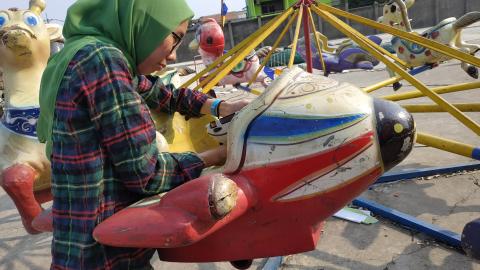Children’s Playgrounds Around the World Pose Lead Paint Danger

International Lead Poisoning Prevention Week of Action Observed in 40 Countries
Gothenburg, Sweden Children’s playgrounds in Indonesia, Malaysia, Mexico, the Philippines, and Thailand have been revealed to contain painted equipment with lead levels above 90 ppm, the recommended limit by UN Environment Program. Playgrounds containing dangerously high levels of lead exceeding 10,000 ppm were discovered in four of the countries studied. The concerning data was released during the International Lead Poisoning Prevention Week (October 20-26, 2019) spearheaded by the Global Alliance to Eliminate Lead Paint that is observing its 10th anniversary this year. Environmental health experts say the data underscores the ongoing need for strong lead paint bans that is inclusive not just of decorative paints, but all types of paint irrespective of use. Lead paint, a major source of childhood lead exposure, can cause permanent and irreversible brain damage in children. Lead is especially dangerous to children’s developing brains, and can cause reduced intelligence quotient (IQ) and attention span, impaired learning ability, and increased risk of behavioral problems. There is no known level of lead exposure without harmful effects. The analysis of lead in playground equipment was conducted by IPEN member organizations in Indonesia, Malaysia, Mexico, the Philippines and Thailand where lead content on playground equipment was measured using a portable X-Ray Fluorescence spectrometer.
Key findings:
- The analysis included an array of equipment intended for children’s playground use including climbing bars and structures, ramps, rockers, see-saws, slides, and swings.
- 85% of the equipment tested in the five countries exceeded the 90 ppm UNEP-recommended limit.
- In Malaysia, Mexico, the Philippines, and Thailand, several pieces of playground equipment contained dangerously high levels of lead above 10,000 ppm, with lead levels reaching greater than 100,000 ppm were found in playground equipment in Malaysia, Mexico and the Philippines.
- The highest lead levels were detected in yellow-painted play equipment with the exception of Thailand where the highest level detected was on red monkey-bars:
- Jakarta, Indonesia: 4,170 ppm in a yellow slide-and-swing combined structure;
- Penang, Malaysia: 620,000 ppm in a yellow multi-layered metallic handle structure;
- Baguio City, Philippines: 663,000 ppm on a yellow-painted surface of a multi-purpose play equipment;
- Bangkok City, Thailand: 72,300 ppm in red monkey bars; and
- Guadalajara, Mexico: 25 percent of playground equipment sampled contained lead levels above 100,000 ppm.
“Children’s health and future are threatened by any amount of lead exposure,” explains Manny Calonzo, IPEN Advisor, and winner of the Goldman Environmental Prize for his alliance work in the Philippines with EcoWaste Coalition to win strong lead paint regulation and a lead-safe paint market. “Playgrounds should be fun and safe spaces for kids, not sites of hazardous exposures. Coatings on equipment inevitably flake and chip from weathering and regular wear and tear, become mixed in the sand and dirt, and put children at risk of life-long impairment from ingestion through normal hand to mouth behavior. We can do better.”
IPEN’s global lead paint elimination campaign is working with the World Health Organization, the UN Environment Program and other partners in the Global Alliance to Eliminate Lead Paint. The past decade has seen the adoption of lead paint regulations in many countries where NGOs campaign to eliminate the threat of lead in paint. Work in e.g. Cameroon, Ethiopia, Kenya, and Tanzania in Africa; and Bangladesh, India, Nepal, Philippines, Sri Lanka, and Thailand in Asia through multi-country and national lead paint studies, national campaigns have led to new or strengthened regulations.
Environmental health experts along with many paint manufacturers stress that elimination of lead paint is a viable goal, as safe and affordable alternatives to lead additives are widely available. Paint manufacturers in many countries have developed lead-safe paint formulas with companies in the Philippines, Sri Lanka and Bangladesh successfully obtaining third-party Lead Safe Paint® Certification.
“Despite our knowledge that lead profoundly damages children’s health, an alarming amount of lead paint continues to be sold in all regions of the world. We need concerted efforts to prohibit lead in all types of paint, not only decorative house paints. Leaded industrial paint for outdoor equipment and streets contain some of the highest levels of lead and are serious and preventable health threats to children. While some manufacturers have begun removing lead from their products, governments must act now to adopt strong regulatory controls to ban lead paint and improve life chances of children in their countries.” Said Dr. Sara Brosché, Manager of IPEN´s Global Campaign to Eliminate Lead Paint.
###
For interviews, reports, and additional information, please contact Dr. Sara Brosché (SaraBrosché@ipen.org) or Manny Calonzo (Manny@ipen.org).
Contacts: Manny Calonzo, manny@ipen.org, +63 917-836-4691
Sara Brosché, sarabrosche@ipen.org
The following organizations conducted the playground paint sampling:
Nexus3 Foundation–Indonesia, EcoWaste Coalition–Philippines, EARTH–Thailand, CAP– Malaysia, and
Casa Cem–Mexico
IPEN is a global network of more than 500 health and environmental public interest organizations in over 120 countries, working to eliminate the world's most harmful chemicals to create a toxics-free future.
